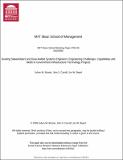Dueling Stakeholders and Dual-Hatted Systems Engineers: Engineering Challenges, Capabilities and Skills in Government Infrastructure Technology Projects
Author(s)
Brooks, JoAnn M.; Carroll, John S.; Beard, Jon W.
DownloadSSRN-id1481911.pdf (215.0Kb)
Metadata
Show full item recordAbstract
Engineering projects that support government enterprises face substantial challenges due to demands from diverse stakeholders and rapidly-changing technologies. In this paper, we present findings from analysis of five case studies of systems engineering projects for large government enterprises. We focus on what can be learned from systems engineers, their essential role, and their engineering practices. As they work to establish interoperability across pre-existing and new technologies - thereby evolving infrastructure - the engineers commonly face “agonistic” tensions between groups of stakeholders. Temporal pacing conflicts are especially prevalent, such as those between stakeholder groups concerned with fast-paced streams of innovation and stakeholder groups concerned with current operations. In response, many engineers are following an evolutionary approach, developing new capabilities for managing projects and individual professional skill sets. The engineers’ adaptive response can be understood as incremental modularization and re/integration of technologies and associated practices across organizational (stakeholder) boundaries. Additionally, engineers are developing new skills of influence to support these capabilities for addressing stakeholder tensions. We close by discussing implications of our findings for the management of infrastructure technology projects, emergent design and engineering of organizational infrastructure, and the changing role of systems engineers.
Description
An earlier version of this work was presented at the EGOS 2008 Summer Colloquium.
Date issued
2009-10-02Publisher
Cambridge, MA; Alfred P. Sloan School of Management, Massachusetts Institute of Technology
Series/Report no.
MIT Sloan School of Management Working Paper;4761-09